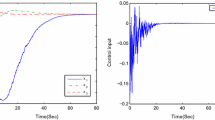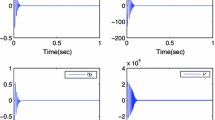Abstract
For a class of more general stochastic high-order feedforward nonlinear systems, this paper deals with the problem of state feedback stabilization. By introducing an appropriate coordinate transformation, the original system is transformed into an equivalent one with tunable gain. After that, by reasonably extending the homogeneous domination approach and skillfully choosing the low gain scale, a state feedback controller is explicitly constructed to render the closed-loop system globally asymptotically stable in probability. Two numerical examples are provided to demonstrate the effectiveness of the proposed design method.


Similar content being viewed by others
References
M. Arcak, A. Teel, P. Kokotovic, Robust nonlinear control of feedforward systems with unmodeled dynamics. Automatica 37(2), 265–272 (2001)
G. Arslan, T. Basar, Decentralized risk-sensitive controller design for strict-feedback systems. Syst. Control Lett. 50(5), 383–393 (2003)
Y. Chen, A.K. Xue, S.S. Zhou, R.Q. Lu, Delay-dependent robust control for uncertain stochastic time-delay systems. Circuits Syst. Signal Process. 27(4), 447–460 (2008)
T.S. Chen, J. Huang, Global robust output regulation by state feedback for strict feedforward systems. IEEE Trans. Autom. Control 54(9), 2157–2163 (2009)
S.H. Ding, C.J. Qian, S.H. Li, Global stabilization of a class of feedforward systems with lower-order nonlinearities. IEEE Trans. Autom. Control 55(3), 691–696 (2010)
S.H. Ding, C.J. Qian, S.H. Li, Q. Li, Global stabilization of a class of upper-triangular systems with unbounded or uncontrollable linearizations. Int. J. Robust Nonlinear Control 21(3), 271–294 (2011)
H.B. Du, C.J. Qian, S.H. Li, Global stabilization of a class of uncertain upper-triangular systems under sampled-data control. Int. J. Robust Nonlinear Control 23(6), 620–637 (2013)
P. Florchinger, Lyapunov-like techniques for stochastic stability. SIAM J. Control Optim. 33(4), 1151–1169 (1995)
F. Grognard, R. Sepulchre, G. Bastin, Global stabilization of feedforward systems with exponentially unstable Jacobian linearization. Syst. Control Lett. 37(2), 107–115 (1999)
R.Z. Has’minskii, Stochastic stability of differential equations (Kluwer Academic Publishers, Norwell, 1980)
G. Kaliora, A. Astolfi, Nonlinear control of feedforward systems with bounded signals. IEEE Trans. Autom. Control 49(11), 1975–1990 (2004)
G. Kaliora, A. Astolfi, On the stabilization of feedforward systems with bounded control. Syst. Control Lett. 54(3), 263–270 (2005)
H.K. Khalil, Nonlinear systems, 3rd edn. (Prentice-Hall, New Jersey, 2002)
M. Krstic, H. Deng, Stabilization of uncertain nonlinear systems (Springer, New York, 1998)
H.J. Kushner, Stochastic stability and control (Academic Press, New York, 1967)
W.Q. Li, Y.W. Jing, S.Y. Zhang, Output-feedback stabilization for stochastic nonlinear systems whose linearizations are not stabilizable. Automatica 46(4), 752–760 (2010)
L. Liu, S. Yin, H.J. Gao, F. Alsaadi, T. Hayat, Adaptive partial-state feedback control for stochastic high-order nonlinear systems with stochastic input-to-state stable inverse dynamics. Automatica 51(1), 285–291 (2015)
L. Liu, M. Gao, State feedback control for stochastic feedforward nonlinear systems. Math. Probl. Eng. 2013, 1–6 (2013)
L. Liu, X.J. Xie, Output-feedback stabilization for stochastic high-order nonlinear systems with time-varying delay. Automatica 47(12), 2772–2779 (2011)
L. Liu, X.J. Xie, State feedback stabilization for stochastic feedforward nonlinear systems with time-varying delay. Automatica 49(4), 936–942 (2013)
L. Marconi, A. Isidori, Robust global stabilization of a class of uncertain feedforward nonlinear systems. Syst. Control Lett. 41(4), 281–290 (2000)
G. Mavelli, P. Palumbo, The Carleman approximation approach to solve a stochastic nonlinear control problem. IEEE Trans. Autom. Control 55(4), 976–982 (2010)
F. Mazenc, S. Bowong, Tracking trajectories of the cart-pendulum system. Automatica 39(4), 677–684 (2003)
F. Mazenc, L. Praly, Adding integrations, saturated controls and stabilization for feedforward systems. IEEE Trans. Autom. Control 41(11), 1559–1578 (1996)
C.J. Qian, J. Li, Global output feedback stabilization of upper-triangular nonlinear systems using a homogeneous domination approach. Int. J. Robust Nonlinear Control 16(9), 441–463 (2006)
C.J. Qian, W. Lin, Homogeneity with incremental degrees and global stabilization of a class of high-order upper-triangular systems. Int. J. Control 85(12), 1851–1864 (2012)
R. Sepulchre, M. Jankovic, P.V. Kokotovic, Constructive nonlinear control (Springer-Verlag, New York, 1996)
A.R. Teel, A nonlinear small gain theorem for the analysis of control systems with saturation. IEEE Trans. Autom. Control 41(9), 1256–1270 (1996)
J. Tsinias, Stochastic input-to-state stability and applications to global feedback stabilization. Int. J. Control 71(5), 907–930 (1998)
J. Tsinias, M.P. Tzamtzi, An explicit formula of bounded feedback stabilizers for feedforward systems. Syst. Control Lett. 43(4), 247–261 (2001)
Z.J. Wu, M.Y. Cui, P. Shi, H.R. Karimi, Stability of stochastic nonlinear systems with state-dependent switching. IEEE Trans. Autom. Control 58(8), 1904–1918 (2013)
X.J. Xie, L. Liu, Further results on output feedback stabilization for stochastic high-order nonlinear systems with time-varying delay. Automatica 48(10), 2577–2586 (2012)
X.J. Xie, L. Liu, A homogeneous domination approach to state feedback of stochastic high-order nonlinear systems with time-varying delay. IEEE Trans. Autom. Control 58(2), 494–499 (2013)
S.L. Xie, L.H. Xie, Decentralized stabilization of a class of interconnected stochastic nonlinear systems. IEEE Trans. Autom. Control 45(1), 132–137 (2000)
S.Y. Xu, J. Lam, H.J. Gao, Y. Zou, Robust \(H_{\infty }\) filtering for uncertain discrete stochastic systems with time delays. Circuits Syst. Signal Process. 24(6), 753–770 (2005)
X.D. Ye, Universal stabilization of feedforward nonlinear systems. Automatica 39(1), 141–147 (2003)
X.D. Ye, Pseudo-decentralized adaptive stabilization of large-scale feedforward nonlinear systems. Automatica 45(5), 1232–1236 (2009)
L.X. Zhang, E.K. Boukas, J. Lam, Analysis and synthesis of Markov jump linear systems with time-varying delays and partially known transition probabilities. IEEE Trans. Autom. Control 53(10), 2458–2464 (2008)
X.F. Zhang, E.K. Boukas, Y.G. Liu, L. Baron, Asymptotic stabilization of high-order feedforward systems with delays in the input. Int. J. Robust Nonlinear Control 20(12), 1395–1406 (2010)
X.F. Zhang, Q.R. Liu, L. Baron, E.K. Boukas, Feedback stabilization for high order feedforward nonlinear time-delay systems. Automatica 47(5), 962–967 (2011)
G.D. Zhao, X.J. Xie, A homogeneous domination approach to state feedback of stochastic high-order feedforward nonlinear systems. Int. J. Control 86(5), 966–976 (2013)
G.M. Zhuang, Y.L. Wei, Non-fragile \(H_{\infty }\) filter design for uncertain stochastic nonlinear time-delay Markovian jump systems. Circuits Syst. Signal Process. 33(11), 3389–3419 (2014)
Acknowledgments
The authors would like to express sincere gratitude to the editor and reviewers for their helpful suggestions in improving the quality of this paper. This work was partially supported by the National Natural Science Foundation of China under Grants 61403041 and 61503036, the Program for Liaoning Excellent Talents in University under Grant LJQ2015001 and the Program for Liaoning Innovative Research Team in University under Grant LT2013023.
Author information
Authors and Affiliations
Corresponding author
Appendix
Appendix
Proof of Lemma 7
(i) We first prove \(r_{n}+\tau \ge \max _{1\le i\le n}\{2r_{i}\}\). By \(r_{1}=1, r_{i+1}=\frac{r_{i}+\tau }{p}\), one has
when \(i=1\), choosing \(d_1=\frac{(2p^{n-1}-1)(p-1)}{p^n-1}\) and \(\tau \ge d_1\), with (29) and \(p\in R_\mathrm{odd}^{>2}\), one can obtain
For \(i=2,\ldots ,n\), choosing \(d_i=\frac{(\frac{2}{p^{i-1}}-\frac{1}{p^{n-1}})(p-1)}{p-2+\frac{2}{p^{i-1}}-\frac{1}{p^{n-1}}}\) and \(\tau \ge d_i\), by (29) and \(p\in R_\mathrm{odd}^{>2}\), one gets
It is easy to conclude that \(d_1>1, 0<d_i<1, i=2,\ldots ,n\). By (30) and (31), \(r_{n}+\tau \ge \max _{1\le i\le n}\{2r_{i}\}\) holds for any \(p\in R_\mathrm{odd}^{>2}\) and \(\tau \in [d_1,+\infty )\).
(ii) For any \(p\in R_\mathrm{odd}^{>2}\) and \(\tau \in [d_1,+\infty )\), one can choose \(l_1\) to satisfy \(r_{n}+\tau \ge \max _{1\le i\le n}\{\frac{r_{i}+\tau }{l_1}\}\).
From (i) and (ii), it follows that \(r_{n}+\tau \ge \max _{1\le i\le n}\{2r_{i}, \frac{r_{i}+\tau }{l_1}\}\). According to the denseness of real number, there exists \(\mu \in R_\mathrm{odd}^{+}\) such that \(r_{n}+\tau \ge \mu \ge \max _{1\le i\le n}\{2r_{i}, \frac{r_{i}+\tau }{l_1}\}\) holds for any \(p\in R_\mathrm{odd}^{>2}\) and \(\tau \in [d_1,+\infty )\). \(\square \)
Proof of Lemma 8
We first prove that \(V_{i}(\eta _1,\ldots ,\eta _{i})\) is \({\mathcal {C}}^2\). By (10) and (12), it is easy to obtain
where \(j,k=1,\ldots ,i-1\) and the last equality is obtained by using \(\frac{\partial ^2{\eta _{i}^{*}}^{\frac{\mu }{r_{i}}}}{\partial \eta _{j}\partial \eta _{k}}=0, j\ne k\). By \(\mu \ge \max _{1\le i\le n}\{2r_{i}, \frac{r_{i}+\tau }{l_1}\}\), \(\frac{\partial {\eta _{i}^{*}}^{\frac{\mu }{r_{i}}}}{\partial \eta _{j}}=-\beta _{i-1}\cdots \beta _j \frac{\mu }{r_j}\eta _j^{\frac{\mu -r_j}{r_j}}\) and \(\frac{\partial ^2{\eta _{i}^{*}}^{\frac{\mu }{r_{i}}}}{\partial \eta _{j}^2}=-\beta _{i-1}\cdots \beta _j \frac{\mu (\mu -r_j)}{r_j^2}\eta _j^{\frac{\mu -2r_j}{r_j}}\), one has \(\frac{q_{i}}{\mu }-2\ge 0, \frac{\mu -r_j}{r_j}\ge 1\) and \(\frac{\mu -2r_j}{r_j}\ge 0\), from which and (32), we know that \(V_i\) is \({\mathcal {C}}^2\).
Next, we divide into two cases to prove that \(V_{i}(\eta _1,\ldots ,\eta _i)\) is positive definite and proper.
Case I When \(\eta _{i}^{*}\le \eta _{i}\), using Lemma 5, one leads to
Case II When \(\eta _{i}^{*}\ge \eta _{i}\), (33) can be proved similarly.
Therefore, \(V_i=V_{i-1}(\eta _1,\ldots ,\eta _{i-1})+U_{i}(\eta _1,\ldots ,\eta _{i})\ge V_{i-1}(\eta _1,\ldots ,\eta _{i-1})+m_{i}(\eta _{i}-\eta _{i}^{*})^{\frac{4l_1\mu -\tau }{r_{i}}}\), which implies that \(V_i(\bar{\eta }_i)\) is positive definite and proper, where \(m_{i}\) is a positive constant.
At last, we prove inequality (13). From (3), (10)–(12) and (32), it follows that
We concentrate on the last two terms on the right-hand side of (34).
When \(\frac{r_{i}p}{\mu }\le 1\), using (10) and Lemma 5, one obtains
when \(\frac{r_{i}p}{\mu }\ge 1\), by (10) and Lemmas 4, 6, there exist positive constants c, \(b_{i1}\) and \(\bar{b}_{i1}\) such that
Combining (35) and (36), by Lemma 4, one has
where \(\tilde{b}_{i1}=\max \{2^{1-\frac{r_{i}p}{\mu }},\bar{b}_{i1}\}\), \(l_{i,i-1,1}\) and \(\rho _{i1}\) are positive constants.
With the help of (10) and Lemmas 4 and 5, one obtains
where \(\bar{d}, \tilde{d}, l_{ij2} (j=1,\ldots ,i-1)\) and \(\rho _{i2}\) are positive constants.
Choosing
and substituting (37)–(39) into (34), the inequality (13) holds. \(\square \)
Rights and permissions
About this article
Cite this article
Liu, L., Xing, X. & Gao, M. Global Stabilization for a Class of Stochastic High-Order Feedforward Nonlinear Systems Via Homogeneous Domination Approach. Circuits Syst Signal Process 35, 2723–2740 (2016). https://doi.org/10.1007/s00034-015-0170-x
Received:
Revised:
Accepted:
Published:
Issue Date:
DOI: https://doi.org/10.1007/s00034-015-0170-x




